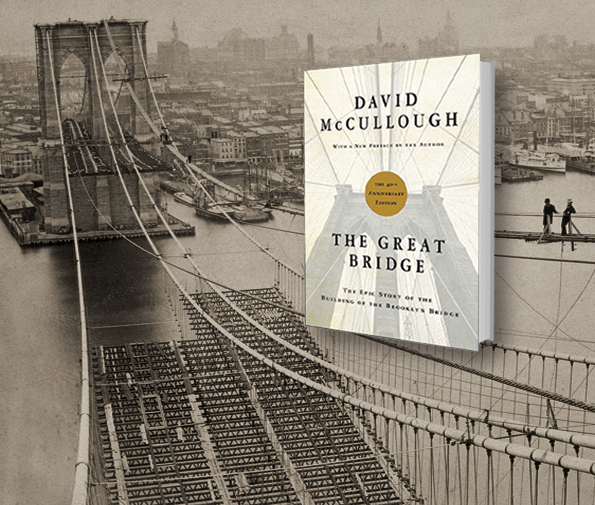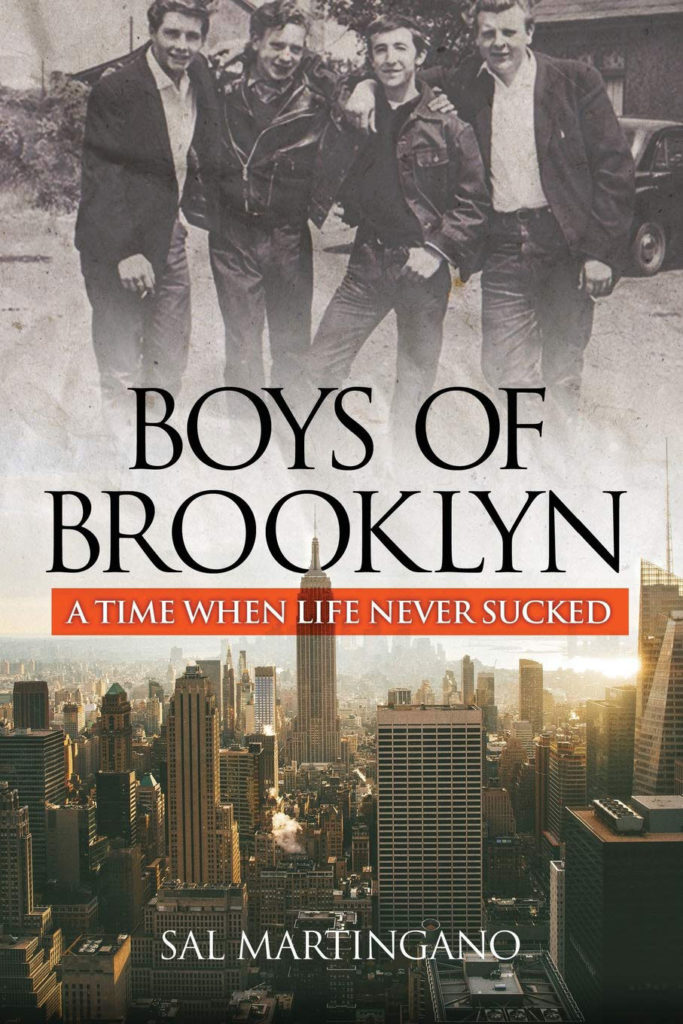The Great Bridge: The Epic Story of the Building of the Brooklyn Bridge

by David McCullough
Book Review by Dr. Sal Martingano, FICPA
“As a baby-boomer who’s also a native New Yorker, the Brooklyn Bridge was the symbol that put my borough on the map and became an indelible triumph for American engineering.”
As an early civil engineering student at City University of New York, I actually studied the incredible challenges faced by 1860’s engineering bridge technology to span some 1,500 ft. between suspension points and over a mile in length and being strong enough to support yet unknown weight loads. My cursory introduction to ‘strength and materials’ dealing specifically with suspension technology, fit nicely into the prepared 1960’s knowledge capsules we studied–but little else was discussed as to how the bridge actually got built.
“I’ve got a bridge to sell you.”
I’m sure most everyone reading this remembers hearing the term: “If you believe that, I’ve got a bridge to sell you“. The phrase was actually referring to the Brooklyn Bridge. An early 19thcentury New York con-man named George Parker was best known for selling the Brooklyn Bridge 13 times to unsuspecting immigrants. In modern times the phrase simply refers to someone who is gullible.
It’s difficult to give reverence to an era before your time. In my book, “The Boys of Brooklyn…a time when life never sucked”, I devoted countless hours detailing the era of first wave baby boomers through the adventures of five life-long friends as well as the incredible impact baby boomers have had on American life, technology and culture.
After reading “The Great Bridge” by David McCullough, I was truly humbled by the impeccable research that went into an era two generations before my boomer years. The story of the Brooklyn Bridge was not only about the bridge designer and engineer, John Roebling, but covered the massive business center that was New York City- as well as the politics of the time that controlled the country. McCullough’s research revealed names, places and the essence of who early 19thcentury Americans were.
The book also covered Brooklyn as a vast land mass that supplied the homes for the ever growing population required to support the working New York City business districts. People need to live where work is plentiful, salaries are sufficient to raise families and supply the lifestyles that are unique to urban living. It was refreshing to read about my boomer stomping grounds from the perspective of how it came to be. Places like Coney Island and Prospect Park were the result of strategic planning and huge sums of investment capital by a precious few who dominated the wealth of both New York City and Brooklyn. It was enlightening to read that our beloved Prospect Park was engineered and developed by the same Roebling family that built the Brooklyn Bridge.
As the Brooklyn boomer generation became of working age, New York City was often the destination of choice. McCullough’s book pointed out that New York City became the destination of choice for big business and high paying jobs but Brooklyn had the vast land masses to build the homes to raise families. The story of ‘The Great Bridge’ gave powerful insights into the need for a more efficient method of transportation. Traversing the East River on a daily basis via the ferry system was inefficient and almost useless during the dead of winter when the East River virtually freezes over.
The politics of the day was filled with special interests and a host of men dedicated to insuring government compliance for their needs. New York City’s political boss, William Tweed had to be assured of an ample financial payoff for his support. McCullough paints a corrupt picture of New York politicians and their ability to separate as much money from the working class as possible for their special needs. It took years to secure the funding, the engineering, the social and political ramifications of developing technologies for underwater ‘caisson’ foundations and a cable system capable of rising to staggering heights over two twin towers.
Over the years I personally crossed the Brooklyn Bridge thousands of times, never giving a thought about the historical significance that McCullough so eloquently documented. The bridge construction took 14 years, involving over 600 workers and cost $15 million (over $320 million in today’s dollars). Records show that over 24 workers died during the construction, including its designer, John Roebling. Amazingly, the bridge is now 136 years old and has withstood the test of time and doubters. Early skeptics caused the stampeding deaths of over a dozen people on opening day when the crowded bridge was rumored it was collapsing. P.T. Barnum put a stop to the rumor when he led 21 elephants over the bridge to prove it was stable. McCullough reminds us not to take the Brooklyn Bridge for granted by interweaving the many characters who either contributed or tried to prevent the construction of the bridge.
“P.T. Barnum led 21 elephants over the Brooklyn Bridge to prove it was stable.”
Ironically, my book; “The Boys of Brooklyn…a time when life never sucked”, chronicles the construction and 1964 completion of the ‘then’ world’s longest suspension bridge, The Verrazano-Narrows Bridge, connecting Brooklyn and Staten Island. The only way to our college in Staten Island from Brooklyn was via ferry, similar to the early 19thcentury mode of traversing the East River to New York City from Brooklyn. We watched all four years of continuous construction and the spanning of over 143,000 miles of cables between the two mammoth towers. We were part of the first cars to cross the bridge without incident (no stampede)! The Verrazano Bridge is 13,700 feet long and took 4 years to build, thanks to the experience and knowledge provided by the 19thcentury engineering and construction of the Brooklyn Bridge.
The boomer generation is grateful to our past generations that gave us the opportunity to significantly add to the greatness of our country, especially the three square miles known as Bensonhurst, Brooklyn.
Come share the experiences and adventures of the “Boys Of Brooklyn…A Time when Life Never Sucked” available on Amazon here.
Extras:
Get a FREE ebook by joining our mailing list today!
We will send you a digital preview of Dr. Sal’s new book America’s Democracy Betrayed.



